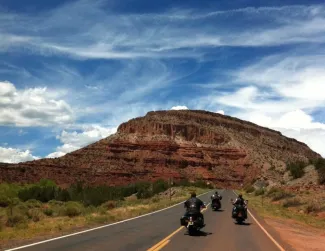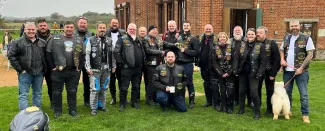There’s something about being on two wheels that just makes sense. You’re in control, out in the elements, and depending on the British weather, either gloriously free or soaked to your socks. But there’s more to motorcycling than just escaping traffic and pretending you’re in a film. Psychologists have actually studied why riding feels so good – and why doing it with others feels even better.
Let’s start with what goes on in your head when you ride. Mihaly Csikszentmihalyi – pronounced roughly how a V-Twin sounds at 4,000 RPM – coined the term “flow” to describe the mental state where you’re completely absorbed in something. Riding fits the bill: the focus, the rhythm, the constant decision-making. You don’t think about your tax return while leaning into a corner – and if you do, you're probably doing one of them wrong. Csikszentmihalyi’s work (1990) shows that this flow state boosts wellbeing and helps us feel more competent and alive.
There’s even evidence that riding sharpens your brain. A Japanese study led by neuroscientist Ryuta Kawashima (2009) found that returning to regular motorcycle use improved cognitive function in middle-aged men – especially in areas like memory and spatial reasoning. In other words, taking the bike out might just keep you sharper than sudoku.
Now let’s talk about the social bit. Riding in a group isn’t just practical – like someone else bringing the tools you forgot – it also builds trust and a strong sense of belonging. Psychologists Henri Tajfel and John Turner (1979) found that being part of a group with shared symbols and routines boosts self-esteem and group loyalty. Sound familiar?
Riding together involves coordination, trust, and sometimes the joint challenge of finding a petrol station that still sells actual fuel and not just coffee. According to Albert Bandura (2000), when a group believes it can achieve things together – whether that’s crossing a mountain pass or getting to the café without losing Dave again – it strengthens the group as a whole. This is known as “collective efficacy”, and it’s the glue that keeps people moving forward together.
And then there’s the bonding effect of mild adversity. One study (Whitehouse et al., 2014) found that shared experiences involving physical effort or risk – think long-distance rides, breakdowns, or biblical downpours – can deepen social bonds. Apparently, nearly missing your turning in synchrony is excellent for trust.
Now, for those of us who are also Freemasons, the connection goes deeper. Freemasonry already brings a shared structure, common values, and a sense of brotherhood. Combine that with the shared identity of being a rider, and you’ve got something quite special: a community built on both tradition and throttle.
So why do we ride? For the thrill, yes. For the peace of mind, absolutely. But also because it’s one of the best ways to connect – to yourself, to others, and to something bigger than either. And if that sounds a bit lofty, don’t worry. You can always just say you’re out for a bacon sandwich and a blast.
Article: Paul Linehan

